The global market cap of cryptocurrencies has plunged around 10% in the past 24 hours to $2.7 trillion as Bitcoin plunged back below $60,000, hitting one-month lows before bouncing back modestly...
Source: Bloomberg
And Ethereum tumbled back near $4100 before bouncing back a little...
Source: Bloomberg
Numerous drivers for the sudden drop have been cited, but none of them are 'new' or 'significant'.
Some analysts also attributed the dip to new tax-reporting requirements for digital currencies that are part of the $550 billion infrastructure bill, which President Joe Biden signed into law Monday. The crypto community has taken particular issue with section 6050II of the bipartisan legislation, which makes failing to report digital assets transactions a criminal offense.
“We’ve seen the U.S. infrastructure bill get signed, which has initiated a selloff from traders who are concerned about regulation and taxation,” said Hayden Hughes, chief executive officer of Alpha Impact, a social-trading platform.
Additionally, more "China cracks down on crypto" FUD headlines hit (hasn't China already double-triple-banned crypto trading and mining?).
Specifically, National Development and Reform Commission spokeswoman Meng Wei said at a press conference that the country will study the option of levying punitive power prices for companies that are involved in cryptocurrency mining.
As Central Bankers will do, The Bank of England’s Sir Jon Cunliffe has urged British lawmakers to think “very hard” about the disruption integrating cryptocurrency with traditional finance could wreak.
Despite acknowledging that “crypto technologies offer a prospect of radical improvements in financial services,” Cunliffe argued that the sector poses significant risks through price volatility, a lack of consumer protection laws, and the absence of Anti-Money Laundering provisions in the decentralized finance sector.
It is worth highlighting that the Bitcoin network was upgraded on Nov. 14 to improve the scripting and privacy capabilities.
From a trading perspective, this creates a potential “sell the news” event, as the improvement was largely expected by the community.
Finally, some have suggested comments from Twitter CFO Ned Segal may have catalyzed some more weakness, as he stated that an investment of Twitter’s corporate cash into crypto assets "doesn’t make sense right now”.
Twitter prefers to hold comparatively stable assets like securities, over the highly volatile Bitcoin on its balance sheet, and that to invest the company’s money in crypto, Twitter “will have to change its investment policy and choose to own assets that are more volatile”.
“There is a different set of decisions we would have to make if we were to own cryptocurrencies on our balance sheet,” said Segal.
All of which is ironic given Twitter CEO Jack Dorsey is one of the highest profile advocates of cryptocurrencies.
On the positive side of the ledger, so-called 'whales' are broadly acting just like in the 2017 bull market, research suggests, 'buying the dip' as Bitcoin price action takes another breather.
“In my opinion, whales and big players usually hedge their Bitcoins by transferring to derivatives exchanges and taking short positions when they buy a huge amount of BTC on price bottoms,” one contributor to fellow on-chain analytics firm CryptoQuant explained Tuesday.
“This pattern is obvious during the last bull run (2017) when the All Exchanges To Derivative Exchanges indicator peaked many times and the price experienced a jump after each time. Right now, during the Bullrun, the metric has peaked four times indicating whales are buying and hedging their coins continuously.”
This, the post summarized, is a “long-term bullish sign” for price action.
Interest in NFTs has reached a record high.
Search queries for “NFT” and “nonfungible token” have become even more popular than searches for “Dogecoin”, “blockchain” and even “Ethereum.”
The spike in interest has seen “NFT” overtake many of keywords that have long-dominated crypto-related search traffic, including “DeFi,” “Ethereum,” and even “blockchain.”
Also, some have suggested this latest leverage-driven over-exuberance is near an end...
Leverage shakeout close to complete$BTC pic.twitter.com/rQyfaT8HUd
— Dylan LeClair 🟠 (@DylanLeClair_) November 16, 2021
Finally, as CoinTelegraph reports, to understand how bullish or bearish professional traders are leaning, one should analyze the futures basis rate. This indicator is frequently referred to as the futures premium, and it measures the difference between longer-term futures contracts and the current spot market levels. A 5%–15% annualized premium is expected in healthy markets, which is a situation known as contango. This price difference is caused by sellers demanding more money to withhold settlement longer.
Bitcoin 3-month futures basis rate. Source: Laevitas.ch
Notice the spike to 20% on Nov. 9 as Bitcoin accumulated 14% gains in three days. This brief period of excessive optimism retracted as BTC corrected 9% after the $69,100 all-time high on Nov. 10 and it appears more of that excess was wrung out overnight.
And, longer-term, Bitcoin's stock-to-flow model suggests a 2018-2019 comeback remains in play...
And finally, Bitcoin managed to close the futures gap that has been in place for over a week...
And amid all this vol, it's worth remembering...
Mankind will only get to live through the process of a completely new, absolutely scarce, digital asset monetizing once.
— Dylan LeClair 🟠 (@DylanLeClair_) November 15, 2021
Just make sure to have some fun along the way.
And inflation shows no signs of slowing...

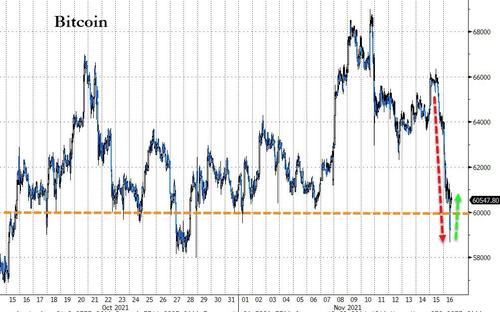
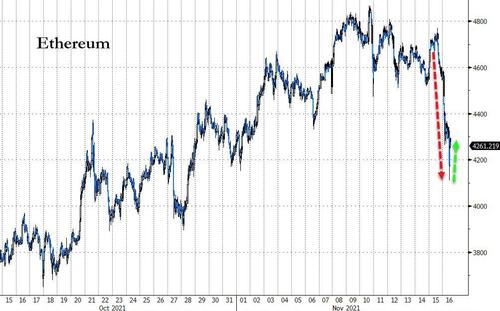


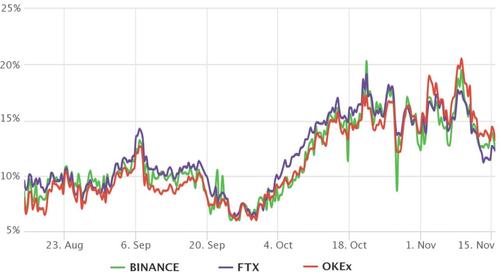

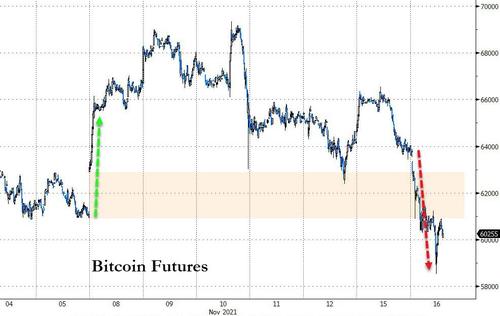
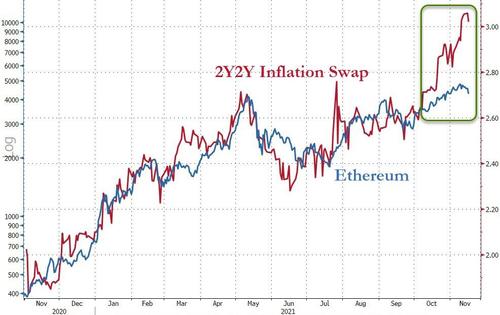










No comments:
Post a Comment